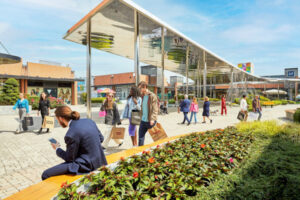BY MORITZ FELIX LÜCK
This question drives investors, operators, and tenants of retail parks. In July, the GfK produced the first verifiable study on the development of e-commerce and its impact on the demand for retail space. Using comprehensive data from a consumer panel and turnover figures and applying them to the diffusion model, the study shows that continuity and change will dominate retail in the future. Critics of such predictions and those who talk of the disappearance of bricks-and-mortar retail are yet to provide an equally comprehensive study based on a similar data density. The fact that integrating e-commerce into the stationary trade is a mandatory task for retailers is unchanged, however. The supposedly apodictic claim “ever online, never offline” is unproven.
This is in part due to a failure to distinguish clearly between pure online players and integrated multichannel retailers in the debate on the future of retailing. Mixing the two forms in the discussion has allowed the spongy statements that have characterized the debate so far. If one looks at current and reliable data on the global retail business, for example, it becomes apparent that only about 20% of the 50 largest online retailers are online pure players (cf. Deloitte Global Powers of Retailing 2015).This is contrasted with a slightly declining proportion, 75%, from integrated, bricks-and-mortar retailers who make part of their turnover online. The same study also shows there are just two online pure players among the 250 largest retailers worldwide. Two! All the others are simply (still) too small to make the leap onto the list of the top 250. The ratio will certainly change in the future, but things are still far from a fundamental shift in favor of online pure players.
The evolutionary pressure of e-commerce on retail is indisputable, and an assumption that retail now has the worst behind it would be a sort of deceptive, self-soothing whistling in the dark. The history of retail shows one thing: If retailers cease to evolve, they simply disappear – whether the business is stationary (e.g. Praktiker) or in classic distance selling (e.g. Neckermann, Quelle).
Back to the demand for space: Overall, in our view, the demand for space across all sectors is stable, with no slowdown in sight. Changes in individual sectors and the corresponding requirements for retail space, however, are changing with increasing speed. The flexibility of real estate in terms of the short-term adaptability of retail spaces is gaining in importance. The aim is during revitalizations, for example, to design spaces and connections to building services so that they can be adapted with little effort to market needs. Owners and operators need to contemplate further reactions to the possible effects of e-commerce in cooperation with tenants. After all, the property itself is only indirectly affected and must react as a trade platform to the needs of retail. Professional and customer-oriented management is thus gaining importance. More on this can be found in the new FMZ report from October.
What is your opinion on this topic? Discuss it with us! Send your opinion to opinion@across-magazine.com !






